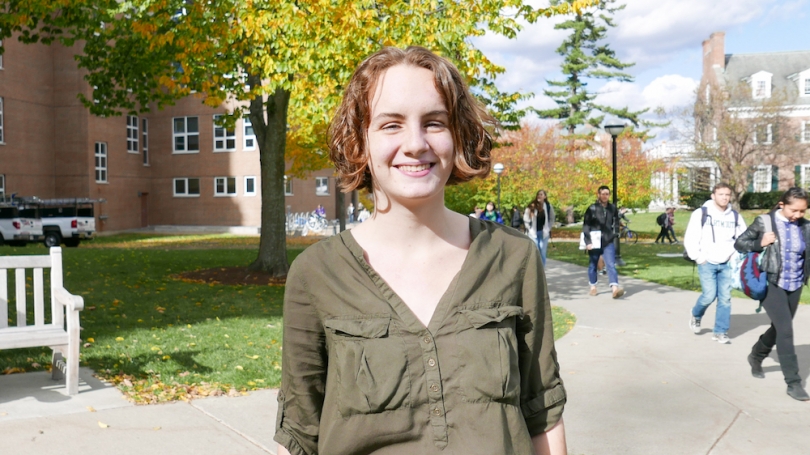
Menu
- About
- Consultation
- Programs
- Resources
- News & Events
Back to Top Nav
Back to Top Nav
Back to Top Nav
An avid traveler from a young age, linguistics major Maggie Baird ’18 has already spent time in 30 countries. Most recently, Baird, a recipient of a Dartmouth Stamps Scholarship, was in northern France, where she interviewed a native speaker of Gulmancema for her current research project.
Baird’s Stamps project, “A Phonological Account of Word-Final Vowel Deletion and Reduction in Gulmancema,” looks at the way sounds are pronounced and structured in Gulmancema, a language natively spoken in Burkina Faso. Her project is guided by Assistant Professor of Linguistics Laura McPherson. Baird also worked with Marc Sepama ’17, a native speaker of Gulmancema, during the early stages of her project.
How did your project come to fruition?
This project came into being when I was taking a class called “Linguistics Field Methods.” We worked with Dartmouth students who spoke other languages. We asked the students to say certain words and phrases and then practiced figuring out the sounds and structure of that language. It was my job to look specifically at phonological rules in Gulmancema. My project started as me figuring out the multiple sounds that exist in a word and how different contexts can affect their pronunciation.
Why does your project matter?
One big issue with linguistics that I notice is that a lot of theoretical frameworks are developed and expanded from Indo-European languages—languages of academia. This is a problem because we’re creating frameworks that are supposed to account for every language in the world, but they’re only being tested on a very specific sub-class of languages. My project is studying a language that hasn’t had a lot of theoretical work done in it.
Where and how have you conducted your research?
This past summer I was in northern France working with a relative of Marc Sepama ’17. What I did and what linguists do in data collection is speech elicitation. I looked at every phrase my consultant said and I cut out the vowels, accounting for different sound environments in Gulmancema. There are certain formants, which are numerical measures, that plot the vowels on a graph. The graph is a 2D representation of a mouth, so it can tell me where the vowel is being pronounced in the mouth. That’s the core data for my project—seeing where these vowels are actually being pronounced in the mouth. I’m in the process of getting all that data to mean something.
What have been the most rewarding parts of your research?
I was listening to some recordings and there was this moment when my consultant said, “It’s funny that when you’re here, I find myself speaking Gulmancema to my friends who don’t even speak Gulmancema.” That made me happy because she was happy to have someone interested in her language. Being a part of that and making that happen was incredible.
I’ve been listening to recordings, clicking on software, and putting data into an Excel spreadsheet. It’s very mundane and very tedious. There was a moment this summer when Professor McPherson said, “Maggie, you need to take a break. Plot your vowels. Just do something else.” I plotted the vowels and for the first time I was actually able to see them in a graph and see what I had done. They were exactly as I had wanted them to be. It was so validating. Being able to see that a 4,000-line Excel spread was not just numbers, but that it actually meant something, was amazing.
The Dartmouth Stamps Scholars Program was established in 2014 in partnership with the Stamps Family Charitable Foundation to recognize and reward exceptional students who exemplify leadership, perseverance, scholarship, service, and innovation. Dartmouth Stamps Scholars are part of a national network of Stamps Scholars located in 40 elite universities across the country. Read more here.